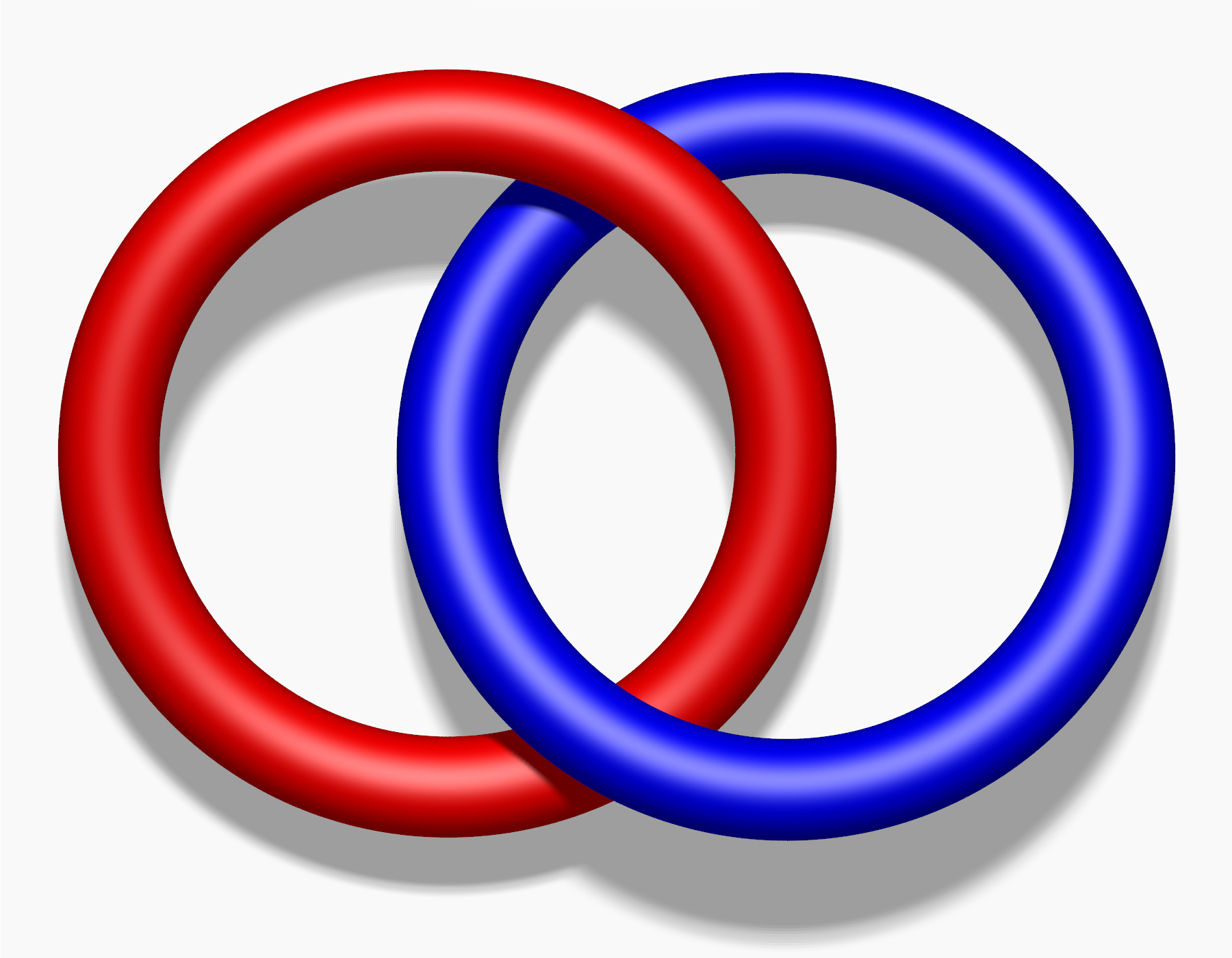|
Dowker–Thistlethwaite Notation
In the mathematical field of knot theory, the Dowker–Thistlethwaite (DT) notation or code, for a knot is a sequence of even integers. The notation is named after Clifford Hugh Dowker and Morwen Thistlethwaite, who refined a notation originally due to Peter Guthrie Tait. Definition To generate the Dowker–Thistlethwaite notation, traverse the knot using an arbitrary starting point and direction. Label each of the n crossings with the numbers 1, ..., 2''n'' in order of traversal (each crossing is visited and labelled twice), with the following modification: if the label is an even number and the strand followed crosses over at the crossing, then change the sign on the label to be a negative. When finished, each crossing will be labelled a pair of integers, one even and one odd. The Dowker–Thistlethwaite notation is the sequence of even integer labels associated with the labels 1, 3, ..., 2''n'' − 1 in turn. Example For example, a ... [...More Info...] [...Related Items...] OR: [Wikipedia] [Google] [Baidu] |
Up To
Two Mathematical object, mathematical objects ''a'' and ''b'' are called equal up to an equivalence relation ''R'' * if ''a'' and ''b'' are related by ''R'', that is, * if ''aRb'' holds, that is, * if the equivalence classes of ''a'' and ''b'' with respect to ''R'' are equal. This figure of speech is mostly used in connection with expressions derived from equality, such as uniqueness or count. For example, ''x'' is unique up to ''R'' means that all objects ''x'' under consideration are in the same equivalence class with respect to the relation ''R''. Moreover, the equivalence relation ''R'' is often designated rather implicitly by a generating condition or transformation. For example, the statement "an integer's prime factorization is unique up to ordering" is a concise way to say that any two lists of prime factors of a given integer are equivalent with respect to the relation ''R'' that relates two lists if one can be obtained by reordering (permutation) from the other. As anot ... [...More Info...] [...Related Items...] OR: [Wikipedia] [Google] [Baidu] |
Gauss Notation
Gauss notation (also known as a Gauss code or Gauss word) is a notation for mathematical knots. It is created by enumerating and classifying the crossings of an embedding of the knot in a plane. It is named for the mathematician Carl Friedrich Gauss (1777–1855). Gauss code represents a knot with a sequence of integers. However, rather than every crossing being represented by two different numbers, crossings are labeled with only one number. When the crossing is an overcrossing, a positive number is listed. At an undercrossing, a negative number. For example, the trefoil knot in Gauss code can be given as: 1,−2,3,−1,2,−3. Gauss code is limited in its ability to identify knots by a few problems. The starting point on the knot at which to begin tracing the crossings is arbitrary, and there is no way to determine which direction to trace in. Also, Gauss code is unable to indicate the handedness of each crossing, which is necessary to identify a knot versus its mirror. For exam ... [...More Info...] [...Related Items...] OR: [Wikipedia] [Google] [Baidu] |
Conway Notation (knot Theory)
In knot theory, Conway notation, invented by John Horton Conway, is a way of describing knots that makes many of their properties clear. It composes a knot using certain operations on tangles to construct it. Basic concepts Tangles In Conway notation, the tangles are generally algebraic 2-tangles. This means their tangle diagrams consist of 2 arcs and 4 points on the edge of the diagram; furthermore, they are built up from rational tangles using the Conway operations. he following seems to be attempting to describe only integer or 1/n rational tanglesTangles consisting only of positive crossings are denoted by the number of crossings, or if there are only negative crossings it is denoted by a negative number. If the arcs are not crossed, or can be transformed into an uncrossed position with the Reidemeister moves, it is called the 0 or ∞ tangle, depending on the orientation of the tangle. Operations on tangles If a tangle, ''a'', is reflected on the NW-SE line, it is den ... [...More Info...] [...Related Items...] OR: [Wikipedia] [Google] [Baidu] |
Alexander–Briggs Notation
In the mathematical field of topology, knot theory is the study of mathematical knots. While inspired by knots which appear in daily life, such as those in shoelaces and rope, a mathematical knot differs in that the ends are joined so it cannot be undone, the simplest knot being a ring (or "unknot"). In mathematical language, a knot is an embedding of a circle in 3-dimensional Euclidean space, \mathbb^3 (in topology, a circle is not bound to the classical geometric concept, but to all of its homeomorphisms). Two mathematical knots are equivalent if one can be transformed into the other via a deformation of \mathbb^3 upon itself (known as an ambient isotopy); these transformations correspond to manipulations of a knotted string that do not involve cutting it or passing through itself. Knots can be described in various ways. Using different description methods, there may be more than one description of the same knot. For example, a common method of describing a knot is a planar di ... [...More Info...] [...Related Items...] OR: [Wikipedia] [Google] [Baidu] |
Ménage Problem
In combinatorial mathematics, the ménage problem or problème des ménages asks for the number of different ways in which it is possible to seat a set of male-female couples at a round dining table so that men and women alternate and nobody sits next to his or her partner. This problem was formulated in 1891 by Édouard Lucas and independently, a few years earlier, by Peter Guthrie Tait in connection with knot theory. For a number of couples equal to 3, 4, 5, ... the number of seating arrangements is :12, 96, 3120, 115200, 5836320, 382072320, 31488549120, ... . Mathematicians have developed formulas and recurrence equations for computing these numbers and related sequences of numbers. Along with their applications to etiquette and knot theory, these numbers also have a graph theoretic interpretation: they count the numbers of matchings and Hamiltonian cycles in certain families of graphs. Touchard's formula Let ''M''''n'' denote the number of seating arrangements for ''n'' cou ... [...More Info...] [...Related Items...] OR: [Wikipedia] [Google] [Baidu] |
Chirality
Chirality is a property of asymmetry important in several branches of science. The word ''chirality'' is derived from the Greek (''kheir''), "hand", a familiar chiral object. An object or a system is ''chiral'' if it is distinguishable from its mirror image; that is, it cannot be superimposed onto it. Conversely, a mirror image of an ''achiral'' object, such as a sphere, cannot be distinguished from the object. A chiral object and its mirror image are called ''enantiomorphs'' (Greek, "opposite forms") or, when referring to molecules, '' enantiomers''. A non-chiral object is called ''achiral'' (sometimes also ''amphichiral'') and can be superposed on its mirror image. The term was first used by Lord Kelvin in 1893 in the second Robert Boyle Lecture at the Oxford University Junior Scientific Club which was published in 1894: Human hands are perhaps the most recognized example of chirality. The left hand is a non-superimposable mirror image of the right hand; no matter ho ... [...More Info...] [...Related Items...] OR: [Wikipedia] [Google] [Baidu] |
Connected Sum
In mathematics, specifically in topology, the operation of connected sum is a geometric modification on manifolds. Its effect is to join two given manifolds together near a chosen point on each. This construction plays a key role in the classification of closed surfaces. More generally, one can also join manifolds together along identical submanifolds; this generalization is often called the fiber sum. There is also a closely related notion of a connected sum on knots, called the knot sum or composition of knots. Connected sum at a point A connected sum of two ''m''-dimensional manifolds is a manifold formed by deleting a ball inside each manifold and gluing together the resulting boundary spheres. If both manifolds are oriented, there is a unique connected sum defined by having the gluing map reverse orientation. Although the construction uses the choice of the balls, the result is unique up to homeomorphism. One can also make this operation work in the smooth categor ... [...More Info...] [...Related Items...] OR: [Wikipedia] [Google] [Baidu] |
Prime Knot
In knot theory, a prime knot or prime link is a knot that is, in a certain sense, indecomposable. Specifically, it is a non-trivial knot which cannot be written as the knot sum of two non-trivial knots. Knots that are not prime are said to be composite knots or composite links. It can be a nontrivial problem to determine whether a given knot is prime or not. A family of examples of prime knots are the torus knots. These are formed by wrapping a circle around a torus ''p'' times in one direction and ''q'' times in the other, where ''p'' and ''q'' are coprime integers. Knots are characterized by their crossing numbers. The simplest prime knot is the trefoil with three crossings. The trefoil is actually a (2, 3)-torus knot. The figure-eight knot, with four crossings, is the simplest non-torus knot. For any positive integer ''n'', there are a finite number of prime knots with ''n'' crossings. The first few values are given in the following table. : Enantiomorphs are counted ... [...More Info...] [...Related Items...] OR: [Wikipedia] [Google] [Baidu] |
Mathematics
Mathematics is an area of knowledge that includes the topics of numbers, formulas and related structures, shapes and the spaces in which they are contained, and quantities and their changes. These topics are represented in modern mathematics with the major subdisciplines of number theory, algebra, geometry, and analysis, respectively. There is no general consensus among mathematicians about a common definition for their academic discipline. Most mathematical activity involves the discovery of properties of abstract objects and the use of pure reason to prove them. These objects consist of either abstractions from nature orin modern mathematicsentities that are stipulated to have certain properties, called axioms. A ''proof'' consists of a succession of applications of deductive rules to already established results. These results include previously proved theorems, axioms, andin case of abstraction from naturesome basic properties that are considered true starting points of ... [...More Info...] [...Related Items...] OR: [Wikipedia] [Google] [Baidu] |
Knot Diagram
In the mathematical field of topology, knot theory is the study of mathematical knots. While inspired by knots which appear in daily life, such as those in shoelaces and rope, a mathematical knot differs in that the ends are joined so it cannot be undone, the simplest knot being a ring (or "unknot"). In mathematical language, a knot is an embedding of a circle in 3-dimensional Euclidean space, \mathbb^3 (in topology, a circle is not bound to the classical geometric concept, but to all of its homeomorphisms). Two mathematical knots are equivalent if one can be transformed into the other via a deformation of \mathbb^3 upon itself (known as an ambient isotopy); these transformations correspond to manipulations of a knotted string that do not involve cutting it or passing through itself. Knots can be described in various ways. Using different description methods, there may be more than one description of the same knot. For example, a common method of describing a knot is a planar di ... [...More Info...] [...Related Items...] OR: [Wikipedia] [Google] [Baidu] |
Peter Guthrie Tait
Peter Guthrie Tait FRSE (28 April 1831 – 4 July 1901) was a Scottish mathematical physicist and early pioneer in thermodynamics. He is best known for the mathematical physics textbook '' Treatise on Natural Philosophy'', which he co-wrote with Lord Kelvin, and his early investigations into knot theory. His work on knot theory contributed to the eventual formation of topology as a mathematical discipline. His name is known in graph theory mainly for Tait's conjecture. He is also one of the namesakes of the Tait–Kneser theorem on osculating circles. Early life Tait was born in Dalkeith on 28 April 1831 the only son of Mary Ronaldson and John Tait, secretary to the 5th Duke of Buccleuch. He was educated at Dalkeith Grammar School then Edinburgh Academy. He studied Mathematics and Physics at the University of Edinburgh, and then went to Peterhouse, Cambridge, graduating as senior wrangler and first Smith's prizeman in 1852. As a fellow and lecturer of his college he remai ... [...More Info...] [...Related Items...] OR: [Wikipedia] [Google] [Baidu] |




